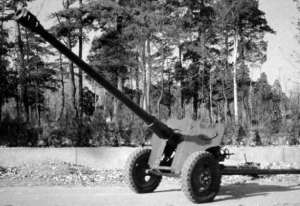| Designation: | Type 56 |
 |
|---|---|---|
| Manufacturer: | NORINCO - China North Industries Group Corporation - CNGC | |
| Product type: | Weapons & Weapon Systems | |
| Name: | Mortar |
The Russian 85 mm Divisional gun D-44 was first supplied to China during the Korean War. China began production of this gun during the early 1960s under the designation Type 56. Some slight changes were made to the original Russian D-44 design to suit Chinese production methods, one of them being the location of a push-rod firing device in the centre of the elevating handwheel.
The NORINCO (China North Industries Corporation) Type 56 does not appear to use the Russian infra-red searchlight and sight system. It has been observed that some NORINCO Type 85 field guns have a castor wheel under the left trail leg to assist in bringing the weapon quickly into action as well as coming out of action.
Ammunition currently available for the Type 56 includes HE, HEAT-FS and HESH. In the past, AP-T and HE-FRAG have been used. The only current projectile for which definite information is available is the NORINCO Type 56 HEAT-FS. This one-piece round weighs 12.5 kg and is 990 mm long. The direct fire maximum range is 970 m at which it will penetrate 100 mm of conventional steel armour set at an angle of 65°. A Dian-1A fuze is used and the muzzle velocity is 845 m/s.
Optical equipment fitted includes a Type 58 panoramic sight with a magnification of ×3.7, Type 85 direct fire sight with a magnification of ×5.5 and a collimator Type 58.
Russia developed and fielded an auxiliary propelled version of the D-44 called the SD-44 but as far as it is known this was never built in China for the People's Liberation Army or offered on the export market by NORINCO. This was developed for use by the Russian airborne forces.
This is understood to be the NORINCO 85 mm field gun Type 56 fitted with the ordnance and recoil system of the Chinese D-30. Details of this system are given in the entry for the NORINCO 122 mm howitzer D-30. As far as it is known, this remains at the prototype stage.
|
||||||||||||||||||||||||||||
|
|||||||||||||||||||||||||||||||||||||||
 |









